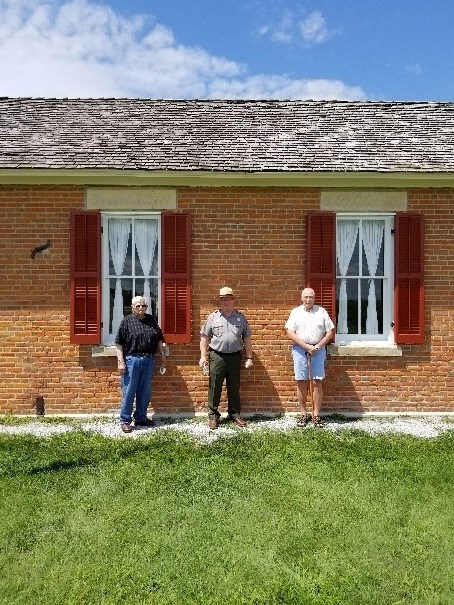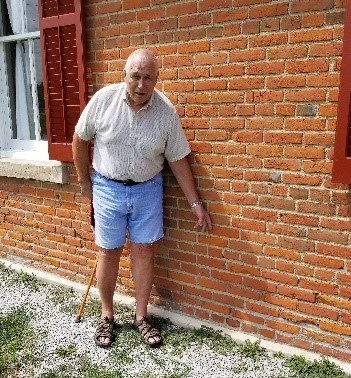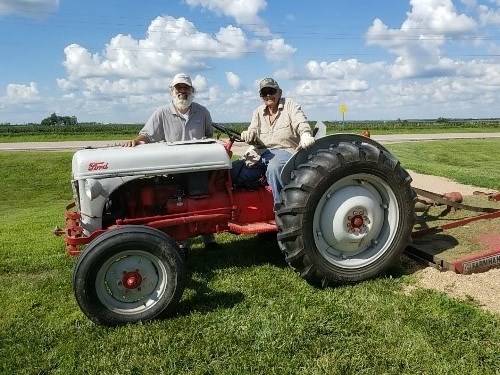Last updated: November 2, 2021
Article
An 1872 One-Room Schoolhouse Reveals Secrets at Homestead National Historical Park

An unassuming one room schoolhouse sits on a small plot of prairie less than a mile west of the Heritage Center at Homestead National Historical Park. The park is four miles west of Beatrice, Nebraska in the state’s southeast corner. The Freeman School was built in 1872, and it was filled with children ages 4 to 20 from 1872 until its closure in 1967. The National Park Service acquired the property in 1970, and it became part of Homestead National Historical Park. In 1978, the National Park Service completed its restoration to its 1870’s period.
The schoolhouse’s claim to history is when Daniel Freeman, the first homesteader, to claim land under the Homestead Act of 1862 witnessed the teacher, Miss Beecher, using the Bible as an instructional tool. The year was 1898. Upon a complaint by Freeman to the school board, the school board sided with the decision of Miss Beecher. Freeman filed suit and lost in Gage County District Court. He then appealed the decision to the Nebraska Supreme Court, and on October 9, 1902, state court ruled favor of Freeman, supporting the theory of the separation of church and state. On the national level, it would not be until 1947 that the United States Supreme Court would apply the Establishment Clause (Everson v. Board of Education), and up to that point allowed states to make their own decisions regarding religious practices in schools.

NPS Photo
Historically, the property saw some changes. There were two gender specific privies 30 feet north of the school. Later, the privies were moved to the west side. The average salary for a teacher from 1882 to 1900 ranged from $32 to $40 per month, and data from the 1964 total operating budget was $5,4448.10. This is a far cry from the $75 for total operating costs in 1872. In 1880, 33 students were enrolled and in 1881, the school provided textbooks for its students. This was 10 years prior to the Nebraska legislature requiring schools to do so. The late decades of the 19th century and first decade of the 20th century saw the widest range of ages with students from five to twenty years old attending. Though a twenty-year-old would provide helpful labor on the homestead, attendance of mature students indicates that homesteaders valued formal education.
As a structure, the school has a front coatroom or coat hall. A wood burning stove sits in the middle of the one main room surrounded by 18 desks in 3 cascading rows. According to the Freeman School Treasurer’s book from 1873, there is an entry for wood for $27. Initially, the stove was started with corn cobs. The desks are constructed with iron work frames, which came from Richmond, Indiana. However, the desks are not original to the school. Traditionally, the primary desks were used by the 5 to 7-year-old students and placed closest to the teacher. The intermediate desks followed for 8 to 13-year-old students. Lastly, 14 to 20-year-old students sat in the back. The theory behind this configuration was that children were comfortable in order to learn. A recitation bench was placed in the front of the room for students to recite their lessons without disturbing the other students in the room as they worked at their desks. The school has a coal shed, and outhouse, a flagpole and at one time, a chimney off the north side, which was removed during the restoration because it was tied up by wire.

NPS Photo
As part of the 2020 Teacher-Ranger-Teacher Program, Christopher, spent the summer of 2020 at Homestead National Historical Park. The Teacher-Ranger-Teacher (TRT) operates as a joint cooperative learning experience for current public-school teachers and is run through the University of Colorado at Denver and the National Park Service. Part of the experience is to create a project for the park. The story of the millions of female homesteaders has not been told at great length, so Christopher’s project was to create 25 condensed accounts, put into booklets, of female homesteaders’ firsthand accounts. These booklets are meant to be read in parts at four stops in the park to give visitors an intimate understanding of a female homesteader’s experience.Part of Christopher’s responsibilities was staffing the 1872 one-room schoolhouse located in the park. One day during his shift he began cataloging the 358 separate locations of where letters or years were left on the bricks or the sandstone sills, noting that some scratches were deep and accurate, while others were faint and up for judgement what letters were carved.

NPS photo
Christopher worked with Park Staff to learn more about the initials. He learned that often the students that attended the school carved their initials in the bricks. Noticing an 1898 on one brick, he became fascinated. Christopher began to use census and school records connected to the Freeman School to catalog the location of each brick using cardinal directions, and a numbering system.
A lot of the kids that went there from the time I did were somewhat related. We went to church with them. We had a teacher that did a really great job. When I got into 8th grade, when Tri-County started, my math skills were way above everybody else’s. -Don Esau (Freeman School student, 1959 to 1965)
Some of the bricks have faint scratches that are difficult to make out the initials. Others are deep and clear. On the southern facing wall on row 26, brick 6 from the left, was carved: LW 51-53. To test his theory, Christopher again used census and school records, in which he located the name of Lovelle Walker. Lovelle’s last year of attendance was listed 1952-53. Sixty-seven years ago, Lovelle carved those initials on his school wall. That is when Christopher had the thought- someone’s mom, dad or grandparent is on that wall. Would not it be wonderful to reveal whose initials are on the walls? Using a spreadsheet, Christopher logged all the initials with their location and was able to sort them alphabetically. Looking to the census and term records again, he was able to piece together about 75% of the students’ names that attended the Freeman School from 1872 to 1967. These names were sorted alphabetically, and then a cross check with the initials were done. Though there is no way to be certain, the bricks seemed to be carved in clusters by decades and are often carved by older students that attended multiple years. Using this imperfect cross-reference, here is a list of names believed to match the carvings on the brick.
Ivan Abner (1948)
Louise Bindernagel (1922-1929)
Shirley Coffee (1953)
Willie Collett (1894-1806)
Arthur Claassen (1933-1939)
Linda Clifford (1953-1961)
Robert Collett (1886-1895)
William Doyle (1905)
Adolf Esau (1908-1915)
Harvey Esau (1935-1943)
Janice Esau (1961-1965)
Kent Esau (1953-1961)
Lorrie Esau (1908-1911)
Louie Esau (1912-1916)
Martha Esau (1928-1935)
Robert Esau (1953-1962)
Daniel Freeman (1906-1915)
Dottie or Lila Freeman (1910)
Frank Freeman (1886-1892)
James Freeman (1886-1890)
LeClaire Freeman (1891-1906)
Lila Freeman (1904-1915)
Maxine Freeman (1914-1921)
Russel Freeman (1918-1924)
Agatha Hamm (1907-1910)
John Hamm (1907-1910)
Willie Hamm (1908)
LaVerne Hansel (1932-1933)
Elmer Maranville (1912-1923)
Forrest Maranville (1920-1924)
Judith Maranville (1950-53)
Ruth Maranville (1920-1928)
Clarence Odell (1904-1907)
Frank Penner (1930-1936)
Elinor Quackenbuch (1925-1932)
Richard Quackenbuch (1923-24)
Alvin Reimer (1918-1924)
Dean Reimer (1945-1950)
Harold Reimer (1922-1928)
Lawrence Reimer (1943-1947)
Magdalene Reimer (1910-1916)
Ross Reimer (1951-1956)
Walter Schmidt (1936-1937)
Henry Shreve (1886-1893)
Martha Scheve (1889-1904)
Anna Thimm (1938-1945)
Billy Thimm (1954-1965)
Ellen Thimm (1936-1943)
Elizabeth Thimm (1904-1906)
Helen Thimm (1916-1923)
John Thimm (1932-1937)
Larry Thimm (1954-1964)
Martha Thimm (1930-1936)
Ellen Walker (1954-1964)
Lovelle Walker (1947-1952)
Henry Weaver (1890-1893)
Irene Wenke (1929-1930)
Selma Walker (1957-1965)
Anna (Annie) Wiens (1915-1918)
Charles "Charlie" Weins (1937-1943)
Marvin Weins (1941-1948)
| Ronald Weins (1945-1950) |
We would love to have you come to Homestead National Historical Park, so we can show you these bricks. They are part of our national heritage and our local history. To contact Homestead National Historical Park, please call (402) 223-3514.
Resources:
Brown, Lenard E., and Renzo Riddo. Historic Structure Report. Denver: Denver Service Center, Historic Preservation Team, National Park Service, US Department of the Interior, 1973. Print.
Thompson, E. (1973). Freeman School Furnishings Study. National Park Service, Homestead National Monument, Beatrice, Nebraska.
The National Park Service. (2014) Freeman School, Washington, D.C.: Government Printing Office.
“Interview With Louis Esau, May 28, 1973” Oral History Recording Housed at Homestead National Monument of America. Recording: T-27.
http://www.nps.gov/home/index.htm
State of Nebraska, Ex. Rel. Daniel Freeman, v John Scheve, Et, al., in Reportd of Cases in the Supreme Court of Nebraska, Vol. LXV, (Lincoln: State Journal Co., Law Publications, 1904), p. 856.Ibod., pp. 158-171
